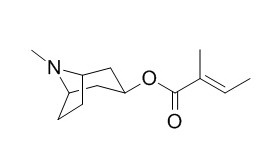Tigloidine
Tigloidine hydrobromide, a naturally occuring analogue of atropine, could be as a substitute for atropine in the treatment of parkinsonism.
Inquire / Order:
manager@chemfaces.com
Technical Inquiries:
service@chemfaces.com
Tel:
+86-27-84237783
Fax:
+86-27-84254680
Address:
1 Building, No. 83, CheCheng Rd., Wuhan Economic and Technological Development Zone, Wuhan, Hubei 430056, PRC
Providing storage is as stated on the product vial and the vial is kept tightly sealed, the product can be stored for up to
24 months(2-8C).
Wherever possible, you should prepare and use solutions on the same day. However, if you need to make up stock solutions in advance, we recommend that you store the solution as aliquots in tightly sealed vials at -20C. Generally, these will be useable for up to two weeks. Before use, and prior to opening the vial we recommend that you allow your product to equilibrate to room temperature for at least 1 hour.
Need more advice on solubility, usage and handling? Please email to: service@chemfaces.com
The packaging of the product may have turned upside down during transportation, resulting in the natural compounds adhering to the neck or cap of the vial. take the vial out of its packaging and gently shake to let the compounds fall to the bottom of the vial. for liquid products, centrifuge at 200-500 RPM to gather the liquid at the bottom of the vial. try to avoid loss or contamination during handling.
Oncology Letters2018, 4690-4696
Anticancer Res.2020, 40(10):5529-5538.
Int J Mol Sci.2021, 22(12):6466.
Legume Science2021, 3(4): e101.
Int J Mol Sci.2017, 18(5)
Srinagarind Medical Journal2017, 32(1)
Applied Biological Chemistry 2021, 64(75)
Microchemical Journal2024, 200:110475
STAR Protoc.2024, 5(2):102990.
Molecular & Cellular Toxicology2022, 10.1007:s13273-022-00277-3
Related and Featured Products
Eur. J. Pharmacol., 1968, 4(3):246-53.
Pharmacology of a potential anti-Parkinson agent: tigloidine.[Pubmed:
5723419]
Pharmacological activity of Tigloidine hydrobromide, a naturally occuring analogue of atropine, was investigated in mice, rats, cats and dogs.
METHODS AND RESULTS:
In mice it markedly antagonized the effects of physostigmine and tremorine but failed to protect the animals against nicotine toxicity. On the autonomic nervous system, it had a weak parasympatholytic and gangliolytic effect compared to atropine and scopolamine. It produced hypotension in the cat which was due to both peripheral and central actions of the drug. Tigloidine did not cause any behavioral abberations in cats and dogs. However, it potentiated the amphetamine-induced behavior changes in these animals. It caused potentiation of mono and polysynaptic reflexes in the cat. In view of the reported usefulness of Tigloidine in the treatment of Parkinson's disease, its probable site and mode of action are discussed.
Phytochemistry,1974,13(10):2143–2144.
Biosynthesis of ticloidine in Physalis peruviana[Reference:
WebLink]
METHODS AND RESULTS:
The aerial parts and roots of Physalis peruviana (Cape Gooseberry) have been shown to contain Tigloidine (3β-tigloyloxytropane) and 3α-tigloyloxytropane.
CONCLUSIONS:
The tiglic acid moiety of these alkaloids is derived from l-iSoleucine.



